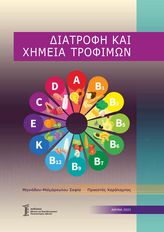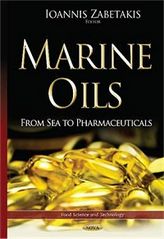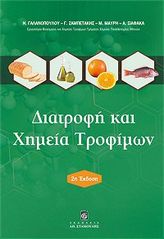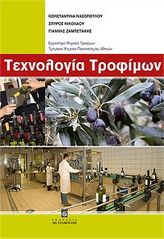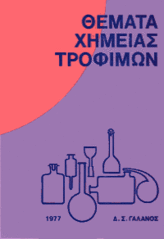BOOKS
Title: "Nutrition and Food Chemistry"
Authors: Ch. Proestos, S. Miniadou Meimaroglou
Contents: Food chemistry plays a vital role in the food industry because it helps Food Technologists understand the ingredients and behavior of foods and nutritionists develop healthy diets. The main goal of nutrition professionals in the modern era is to apply the principles of nutrition to promote health and wellness, prevent disease, and restore health to individuals, families, and society as a whole. To achieve this goal, the application of various scientific principles of food processing and food chemistry is deemed necessary.
This book attempts to present a full range of information on the principles of nutrition as well as food chemistry. It can serve as a practical book for undergraduate/graduate students of Food Chemistry and Technology, Food Science and Nutrition as well as ordinary consumers with an interest in food and nutrition.
Publication details: Publishing house: NKUA Publications, year of publication 2023
Availability: Available from the publisher's website www.ekdoseis.uoa.gr
Title: "Food: Quality Control, Safety and Microbiology"
Authors: Ch. Proestos, P. Markaki
Contents: This book in its first part covers food quality assurance systems, emphasizing the understanding, development and application of the HACCP system. (with Biographical Sketches). Standards for the certification process are also explained (ISO 22000, ISO 9001, FSSC 22000, etc.). In the second part, food microbiology is fully analyzed, which deals exclusively with microorganisms related to food and beverages. Finally, the chapter dedicated to mycotoxins is presented.
The purpose of the first part of the book is also to give the definitions, objectives and stages of quality control. (Inspection of raw materials, production process and final product). Also to study the methods of quality control, and for a small business what the duties of the quality control department are. The main points of the legislation governing quality control and food safety are also mentioned. The aim of the second part is, with the help of the tables and figures, to allow the student-reader, to predict the type and number of micro-organisms that can be found in the different categories of food. So there is also practical interest. For the consumer to be able to apply the appropriate rules to protect himself from harmful and spoilage food microorganisms or to use them when making new products, eg yogurt.
The book is considered essential for undergraduate and postgraduate students of food science as well as science (chemists, biologists, veterinarians, agronomists, microbiologists, food technologists, public health supervisors, nutritionists) as well as scientists and workers in the private and public sector, consultants businesses and executives of mass catering businesses and food businesses in general.
Publication details: Publishing house: DaVinci, year of publication 2017
Availability: Available from the publisher's website www.davinci-books.com
Title: Food Chemistry
Authors: G. Zampetakis, P. Markaki, C. Proestos
Contents: What is the pH of olive oil? What are emulsions? How do lipoids inhibit heart disease?
Some questions that show the magic and complexity of Food Chemistry, the branch of Chemistry that studies food and ultimately offers us both our "livelihood" and "well-being".
This textbook covers, as comprehensively as possible, the subject of Food Chemistry, providing information and scientific data on nutrients useful for human nutrition and how they change from the raw material to the final product.
This book does not aspire to be an encyclopedia but to address contemporary issues of Food Chemistry through examples of modern applied research, tables and figures as a concise and at the same time concise presentation of the most important issues of Food Chemistry.
[See in separate files: contents, back cover].
Publication details: Publications: Ath. Stamoulis, published in 2014, ISBN: 9789603519522 Pages: 407
Title: Marine Oils: From Sea to Pharmaceuticals
Authors: Ioannis Zabetakis (Editor)
Contents: Chapter 1. Sources of Marine Oils (Antony Bimbo) – Chapter 2. Fish requirements of lipids (Jana Pickova, Department of Food Science, Swedish University of Agricultural Sciences (SLU), Sweden) – Chapter 3. Aquaculture and Food Security (Margaret Crumlish, The Institute of Aquaculture, Stirling University, Scotland) – Chapter 4. Marine Oils and Diseases (Ioannis Zabetakis, Laboratory of Food Chemistry Department of Chemistry, National and Kapodistrian, University of Athens, Greece) – Chapter 5. Marine Oils and Inflammation (Constantina Nasopoulou and Ioannis Zabetakis, Department of Food Science and Nutrition, University of the Aegean, and Laboratory of Food Chemistry Department of Chemistry, National and Kapodistrian, University of Athens, Greece) – Chapter 6. Dietary Intervention Studies of Fish and FO/MO: Focus on Secondary Prevention of Cardiovascular Disease and Diabetes (Smaragdi Antonopoulou, Professor in Biochemistry, Director of the Laboratory “Biology, Biochemistry and Physiology”, Tzortzis Nomikos, Elisabeth Fragopoulou and Paraskevi Detopoulou, Harokopio University, Athens, Greece) – Chapter 7. Pharmaceutical Applications of Fish Oils (Alexis Garras, David Fraser, Derek Tobin, Runar Vige and Ida Marie Wold, PronovaBioPharma/BASF, Oslo, Norway) – Chapter 8. Is Fish Something More than Marine Oils? (Ioannis Zabetakis, Laboratory of Food Chemistry Department of Chemistry, National and Kapodistrian, University of Athens, Greece) – Index
Publication details: Publisher: Nova Science Publishers [ https://www.novapublishers.com/catalog/index.php ] Series: Food Science and Technology. ISBN: 9781634637473, ISBN-10: 163463747X. Format: Hardcover. Language: English. Number of Pages: 137. Country of Publication: US, Dimensions (cm): 23.0 x 15.5
[See in separate file (PDF file, 84 KB): Εξώφυλλο, Book Description, Table of Contents].
Title: Nutrition and Food Chemistry (2nd edition)
Authors: N. Galanopoulou, G. Zampetakis, M. Mavri, A. Siafaka
Contents: The sciences of Nutrition and Food Chemistry are two parallel sciences that examine food from different angles. Nutrition deals with food as a source of nutrients, while Food Chemistry sees food as a set of molecules that each has a different structure and properties. The pages of this book attempt to creatively match these two sciences, which helps us better understand the so complex and therefore scientifically challenging and beautiful (bio-)system called food.
The authors examine, among others, topics such as carbohydrates, fats, proteins, water, vitamins, minerals, current nutrition issues, lipids, pigments, taste and aroma, food additives, adverse food components and the application of the HACCP System in the food industry.
This book is useful to students studying Science, but also to those involved in food-related sciences: Technology, Chemistry, Biotechnology, Biochemistry, Nutrition.
[See in separate files: contents, back cover]
Publication details: Publications: Ath. Stamoulis, published in 2011, ISBN: 9789603518631 Pages: 328
Title: Food Legislation & Dietary Risks
Authors: Zampetakis Giannis, Theocharis Stamatios, Karantonis Charalambos, Kirkillis Chrysostomos, Panteloglou Athanasios, Stasinos Sotiris.
Contents: In the ever-increasing dietary risks (hexavalent chromium and other heavy metals, antibiotics, toxins, E. coli) that we face today, food legislation is called upon to protect us. But is the security umbrella (which is the law) sufficient?
Or do some dangers permeate this umbrella and enter our food chain? The above questions we try to answer in this book.
– We describe the main hazards in food and water.
– We assess their dangerousness.
– We identify legal loopholes.
Because in toxicological matters, science is always called upon to take precedence over the law.
We dedicate this book to the ordinary citizen and we hope that with it we will stimulate the legislator to move in the direction that will ensure the best and most effective protection of the health of all of us.
[See in separate files: contents, back cover ]
Publication details: Publications: Ath. Stamoulis, published in 2011, ISBN: 9789603518648 Pages: 192
Title: The Green Crisis
Writers: Antonia Gogkou – Giannis Zampetakis – Linos Kountouras – Theodota Nantsou – Christina Fatourou
Contents: This book is a practical guide (manual) of Crisis Management in the Environment and Nutrition. It includes information on the anatomy of each crisis, examples of crises (from the food industry, agricultural production and environmental pollution to the fires of 2007 and 2009 and the Burgas-Alexandroupolis pipeline) and ways of proper management.
The book is structured as follows: the first six chapters present answers to the six questions: 1. What is a crisis? 2. What are the characteristics/stages of the crisis? 3. Is it possible to predict the crisis? 4. What factors influence the resolution of a crisis? 5. What are the means of exiting the crisis? 6. What should we "keep" from a crisis? Then we present 2 environmental, 2 nutritional crises as well as a crisis from the automotive industry in the form of a case study and with the same structure, as the first six chapters of the book, so that the reader can apply the theory of crisis management in practice.
The book is necessary for students studying law, economics, environmental, political and natural sciences, as well as for Chemists, Biologists, Veterinarians, Agronomists, Microbiologists, Chemical Engineers, Food Technologists, Economists and Lawyers, for employees of auditing bodies of both the private and public sector, for business consultants, for safety and quality officers, for executives of catering companies (chefs, Food and Beverage Managers), for business executives, for executives of advertising organizations and executives of the Public Administration.
[See separate pdf files: contents, back cover]
Publication details: Publications: Ath. Stamoulis, published in 2010, ISBN: 978-960-351-841-9
Title: Food Technology
Writers: Konstantina Nasopoulou – Spyros Nikolaou – Yannis Zampetakis
Contents: The chapters covered have been selected to explain basic concepts of Food Technology as well as terms that will be useful to graduates of Food Science or related Sciences, who may have a career in the Food Industry.
In the 1st chapter, the concept of Food Safety is briefly analyzed, while in the 2nd chapter ways of controlling the quality and processes that take place in a food industry are described. In chapter 3, the most important food preservation methods are analyzed, while in the 4th and 5th chapters the preservation processes that either use or eliminate heat are described. In the 6th chapter, some information about food packaging is mentioned, while in the 7th chapter, an introduction to Food Biotechnology is made. Then, seven food technology exercises are presented, which are taught in the framework of the homonymous course at the Department of Chemistry of the University of Athens. Some important terms related to food are presented as an appendix – glossary and finally, bibliographic references are proposed for further deepening and study.
This book is useful to students studying Science, but also to those involved in food-related sciences: Technology, Chemistry, Biotechnology, Biochemistry, Nutrition.
[See separate pdf files: contents, back cover]
Publication details: Publications: Ath. Stamoulis, published in 2010, ISBN: 978-960-351-833-4
Title: HACCP: FROM H TO P
Authors: Yannis Zampetakis – Nikos Gdontelis
Contents: The book consists of 6 parts. Part 1 sets out the general principles of quality and safety as well as the prerequisites for the successful installation of a HACCP system. Part 2 describes the concept of hazard as well as the different hazards of food. Part 3 presents the seven principles of HACCP. In the 4th part of the HACCP system in a food company a practical description is made and in the 5th part case studies of each stage of the implementation of the HACCP system are presented. For each stage, a different food/product is presented, so that the book has the greatest interest for all sectors of the food industry, while the large-scale HACCP system (Olympic Village 2004) is described. The last part of the book (chapter 6) describes the certification procedures of a company with regard to the new ISO 22000 standard - in an annex, the basic terms of the ISO22000 standard and the main laws that all food companies must apply, while a complete list of permitted additives (E numbers) is provided.
The book is addressed to students of higher education, to all executives of the food industry and to those who deal with food either as consultants or as inspectors - of EFET or individuals.
Publication details: Publishing house: PIPublishing, year of publication 2006
Central Distribution: Bestbookhunters Bookstore, Solonos 47, Athens
Title: Nutrition
Authors: K.A. Dimopoulos, N.K. Andrikopoulos
Contents: Basic concepts of nutrition. Warming value of feed. Energy needs of the body. Explanation of the phenomena arising from life with thermodynamics. Nutrient metabolism. Biological oxidations and photosynthesis. Digestive system. Absorption of nutrients and how they are transported to tissue cells. Nutrient classes. Metabolism of the three main classes of nutrients. Importance of cellulose and fiber. Metabolic connection of the three main classes of nutrients. Metabolic pathways in some human organs of interest to nutrition. Metabolic pathways immediately after food intake and after some time. Diseases of metabolism related to and of interest to the Diet. Mediterranean diet. Vegetarianism. Food allergy. Effect of drugs on the diet. Regulation of gene expression by food components. Changes in food components during heating or microwave cooking. Included: Basic and necessary nutrition knowledge. Complete analysis of ingredients and calories of 200 Fast Food and Fast Food products. Tables for determining energy needs. Alphabetical index (Greek and English).
Publication data: Publication time 1996, 288 pages, 83 formats, 20 tables, ISBN: 960-85833-0-6
Available: A. Bistikia Publications, Koritsas 36 Papagou-156 69. Tel. 210-6512135.
Title: Chemical Evolution and the Origin of Life.
Authors: A.I. Oparin, B.Y. Levin, J.D. Bernal, S.L. Miller, S.W. Fox, R.S. Young, M. Calvin, E. Schroedinger, N.H. Horowitz, J. Monod, R. Monro, B. Donn, H.P. Klein, C. Ponnamperouma, C. Sagan, F. Drake.
Translation: Ath. Valavanidis.
Contents: Editing and translation of the main scientific articles or chapters in conferences and publications, on the topics of chemical evolution, evolution of primitive organisms, search for extraterrestrial living organisms, philosophical dimensions about the origin of life on planet Earth. Scientific texts and researches on the evolutionary biochemical origin of life on Earth and possibly in the Universe.
Publication details: Edition Year 1974, 2nd edition 1978, p. 188.
Distribution: PAPAZISIS Publications, Nikitara 2 and Emm. Benaki, Athens, tel. 210-3622496, 210-3609150.
Title: Introduction to the examination of foodstuffs
Authors: D.S. Galanos, E.K. Voudouris.
Contents: Introduction. Physical and physico-chemical methods. General methods. Examination of natural sweeteners. Examination of fats and oils. Examination of milk and milk products. Examination of cereal products.
Publication details: Edition Year 1971, 2nd edition 1977, 3rd edition 1978, p. 276.
Title: Food Chemistry Topics.
Author: D.S. Galanos
Contents: Part One: Purpose and Importance of Food Chemistry. Nutrients. Human food. Animal food. Fats and oils. Plant food. Eloquently. Water and air. Objects of common use. Sampling and consultation. Part Two: Purpose and Importance of Contemporary Food Chemistry. Taste and food. Contamination of food by pesticide residues. Calcium in the diet and the problem of radioactive Strontium. The intake of fluorides through the modern diet of the Greek. Food additives. Diet and obesity. Diet and atherosclerosis. Man and alcohol. Category of wines. The future of human nutrition.
Publication details: Edition Year 1969, 2nd edition 1975, 3rd edition 1977, p. 374.

